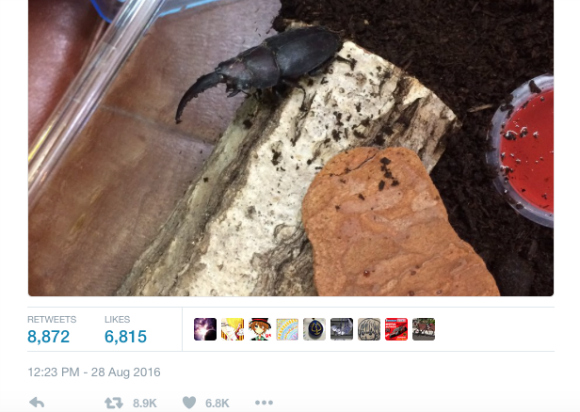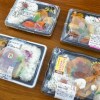
Sometimes fortune just happens to fall – er, crawl – right into your lap!
Usually gaining a nod from the academic community takes years of studying and hard work, but for one Twitter user’s family, all it took was her little brother’s interest in bugs and a good net.
▼ “So my little brother caught this half-male/half-female stag beetle… LOL”
https://twitter.com/suwak1994912161/status/769547037511528448While stag beetles in general are pretty common, and young children all across Japan go bug-catching every summer, finding a specimen like this in the insect world was akin to finding a five (not four)-leaf clover.
▼ “Upon doing a little research, I found out that the likely hood of finding one of these is 1 in every few ten or hundred thousand…”
調べたら数万〜数十万に1匹の確率らしい...
— まち (@suwak1994912161) August 27, 2016
Admittedly I’m not on up on all the details when it comes to differentiating beetle species, but luckily one commenter was able to provide a little more background info on these unique creatures from a book he had at home:
▼ “This is what one of my books had to say about it. ・`ω・) Just wow…”
昆虫本ではこのように紹介されていました。
— 暇人なkohei (@HimajinKohei) August 28, 2016
・`ω・) ス・スゲェ… pic.twitter.com/XzfM7TLztK
Despite not having an internationally recognized English name for these beetles, they’re often referred to as “Rare Hermaphrodite Stag Beetles” among Japanese collectors. Unlike more common Hermaphrodite Stag beetles, the two present sexes are equally divided, with male organs on the male (left) side, and female organs on the female (right) side. Although rare to begin with, an even rarer version has the male side on the right and the female side on the left.
▼ “We finally heard back from an expert! Apparently this half-♂, half-♀ stag beetle is pretty rare, so a local Kagoshima magazine is going to run a story on it.”
鑑定してもらった結果♂♀半々で非常に珍しいらしく鹿児島限定の雑誌に載ることが確定 pic.twitter.com/4CiYF7ngK9
— まち (@suwak1994912161) August 28, 2016
“It’s even rarer than finding a Pokémon!”
“If it has that much scientific value, it shouldn’t be hard to sell it to a collector or organization for a good price…”
“You’d probably make a pretty penny off of it, yeah?”
“Better sell it quick before it dies! You’d rather be 500,000 yen (US$4,830) richer, right?”
Seeing as the last time one of these were found, it was put on display at a museum in Chiba Prefecture, we wouldn’t be surprised to see hardcore insect enthusiasts fighting for the chance to take it home.
Of course, right now, the family’s biggest concern is probably keeping this little creature alive.
Source: Twitter/@suwak1994912161 (1, 2, 3), Twitter/@dcop_Kohei_7 via Hachima Kikou, kerbtier.de
Feature/top image: Twitter/@suwak1994912161
 Extremely Rare Hermaphrodite Stag Beetle on Display in Chiba Prefecture
Extremely Rare Hermaphrodite Stag Beetle on Display in Chiba Prefecture Rare living male-female stag beetle is currently housed in Miyazaki prefectural museum
Rare living male-female stag beetle is currently housed in Miyazaki prefectural museum Private booths are coming to Japan’s Shinkansen bullet trains even sooner than we’d thought【Video】
Private booths are coming to Japan’s Shinkansen bullet trains even sooner than we’d thought【Video】 Japanese beef bowl chain Sukiya’s 2026 Smile Box lucky bag basically pays for itself
Japanese beef bowl chain Sukiya’s 2026 Smile Box lucky bag basically pays for itself Top Japanese cosplayer Enako returns to Comiket after 6 years, creates mayhem with admirers
Top Japanese cosplayer Enako returns to Comiket after 6 years, creates mayhem with admirers The Purple Lucky Bag from Village Vanguard is an extra-large waste of money
The Purple Lucky Bag from Village Vanguard is an extra-large waste of money Dragon Quest Burgers and Slime drinks are coming to McDonald’s Japan【Video】
Dragon Quest Burgers and Slime drinks are coming to McDonald’s Japan【Video】 Rakuten randomly offers 58 New Year’s osechi feasts in Japan, but did we get a star or a dud?
Rakuten randomly offers 58 New Year’s osechi feasts in Japan, but did we get a star or a dud? Japanese shiitake mushroom snacks from Don Quijote, created for people who don’t like mushrooms
Japanese shiitake mushroom snacks from Don Quijote, created for people who don’t like mushrooms We taste makunouchi bento at four Japanese convenience store chains【Taste comparison】
We taste makunouchi bento at four Japanese convenience store chains【Taste comparison】 Coca-Cola Japan unveils new sakura design bottle for cherry blossom season 2019
Coca-Cola Japan unveils new sakura design bottle for cherry blossom season 2019 The 5 best Japanese bento to buy at Kyoto Station
The 5 best Japanese bento to buy at Kyoto Station Starbucks Japan ready to get Year of the Horse started with adorable drinkware and plushies【Pics】
Starbucks Japan ready to get Year of the Horse started with adorable drinkware and plushies【Pics】 Hayao Miyazaki says Happy New Year to Studio Ghibli fans with new art for Year of the Horse
Hayao Miyazaki says Happy New Year to Studio Ghibli fans with new art for Year of the Horse Cup Noodle tries an authentic Jiro-style ramen, but something’s not quite right
Cup Noodle tries an authentic Jiro-style ramen, but something’s not quite right The best Starbucks Japan Frappuccinos we want to drink again in 2026
The best Starbucks Japan Frappuccinos we want to drink again in 2026 We revisited Sweets Paradise after a decade to see if Japan’s dessert buffet still delivers
We revisited Sweets Paradise after a decade to see if Japan’s dessert buffet still delivers That time Seiji called JASRAC to ask why he didn’t get paid royalties for his song being on TV
That time Seiji called JASRAC to ask why he didn’t get paid royalties for his song being on TV We found possibly the quietest Japanese-style hotel in Tokyo’s bustling Shinjuku district
We found possibly the quietest Japanese-style hotel in Tokyo’s bustling Shinjuku district Pizza Hut Japan’s hot lucky bags are perfect for a New Year’s pizza party
Pizza Hut Japan’s hot lucky bags are perfect for a New Year’s pizza party Japan’s oldest largetooth sawfish in captivity back on display in Mie Prefecture
Japan’s oldest largetooth sawfish in captivity back on display in Mie Prefecture 7-Eleven Japan starts new temporary luggage storage service in over 300 branches
7-Eleven Japan starts new temporary luggage storage service in over 300 branches Disillusionment at Tsukiji’s tourist-target prices led us to a great ramen restaurant in Tokyo
Disillusionment at Tsukiji’s tourist-target prices led us to a great ramen restaurant in Tokyo Starbucks teams up with 166-year-old Kyoto doll maker for Year of the Horse decorations【Photos】
Starbucks teams up with 166-year-old Kyoto doll maker for Year of the Horse decorations【Photos】 Tokyo considering law requiring more trash cans following litter increase in heavily touristed area
Tokyo considering law requiring more trash cans following litter increase in heavily touristed area Tokyo’s Tsukiji sushi neighborhood asks tour groups to stay away for the rest of the month
Tokyo’s Tsukiji sushi neighborhood asks tour groups to stay away for the rest of the month Tokyo event lets you travel back in time, for free, to celebrate 100 years since Showa era start
Tokyo event lets you travel back in time, for free, to celebrate 100 years since Showa era start Japan may add Japanese language proficiency, lifestyle classes to permanent foreign resident requirements
Japan may add Japanese language proficiency, lifestyle classes to permanent foreign resident requirements Sanrio theme park in Japan announces plans to expand into a Sanrio resort
Sanrio theme park in Japan announces plans to expand into a Sanrio resort Stamina-destroying “Paralysis Noodles” are Tokyo’s newest over-the-top ramen innovation
Stamina-destroying “Paralysis Noodles” are Tokyo’s newest over-the-top ramen innovation Survey asks foreign tourists what bothered them in Japan, more than half gave same answer
Survey asks foreign tourists what bothered them in Japan, more than half gave same answer Japan’s human washing machines will go on sale to general public, demos to be held in Tokyo
Japan’s human washing machines will go on sale to general public, demos to be held in Tokyo Japan’s deadliest food claims more victims, but why do people keep eating it for New Year’s?
Japan’s deadliest food claims more victims, but why do people keep eating it for New Year’s? We deeply regret going into this tunnel on our walk in the mountains of Japan
We deeply regret going into this tunnel on our walk in the mountains of Japan Studio Ghibli releases Kodama forest spirits from Princess Mononoke to light up your home
Studio Ghibli releases Kodama forest spirits from Princess Mononoke to light up your home Major Japanese hotel chain says reservations via overseas booking sites may not be valid
Major Japanese hotel chain says reservations via overseas booking sites may not be valid Put sesame oil in your coffee? Japanese maker says it’s the best way to start your day【Taste test】
Put sesame oil in your coffee? Japanese maker says it’s the best way to start your day【Taste test】 No more using real katana for tourism activities, Japan’s National Police Agency says
No more using real katana for tourism activities, Japan’s National Police Agency says Starbucks Japan reveals new sakura drinkware collection, inspired by evening cherry blossoms
Starbucks Japan reveals new sakura drinkware collection, inspired by evening cherry blossoms Updated cherry blossom forecast shows extra-long sakura season for Japan this year
Updated cherry blossom forecast shows extra-long sakura season for Japan this year
Leave a Reply